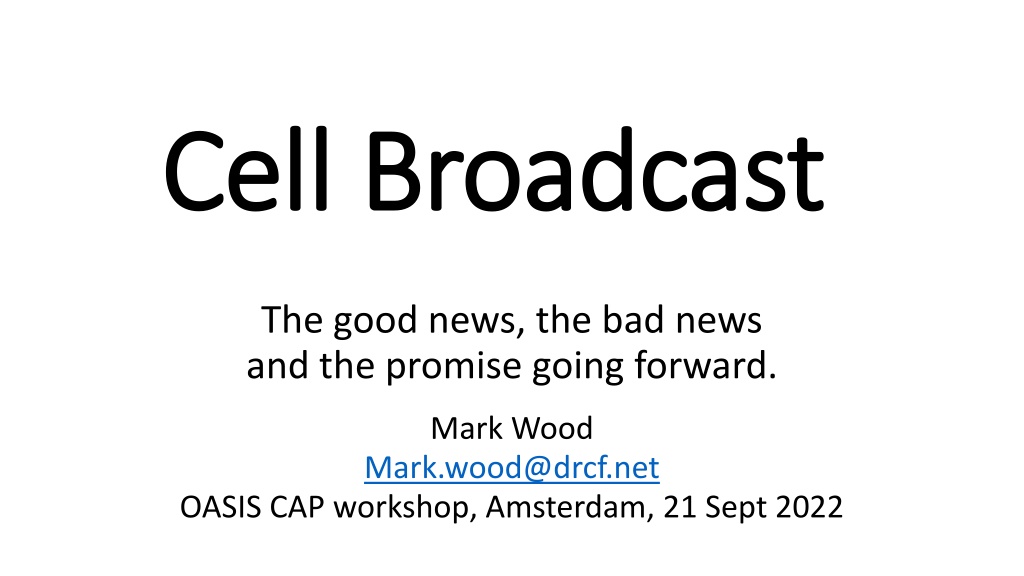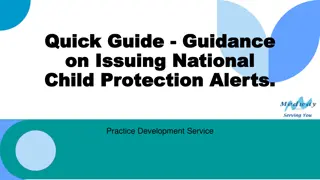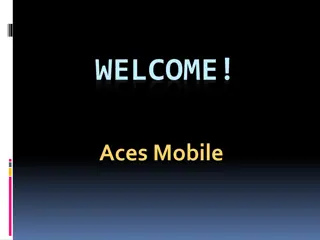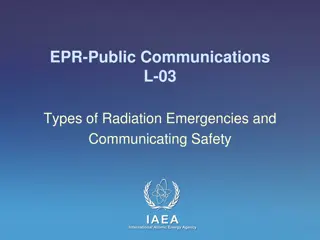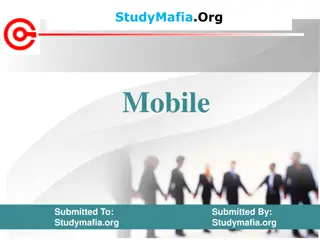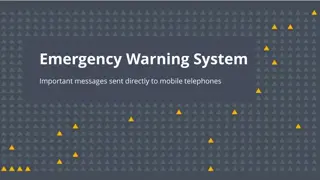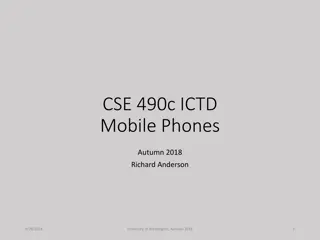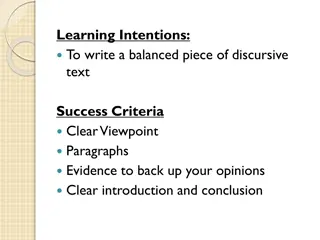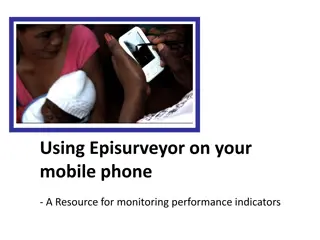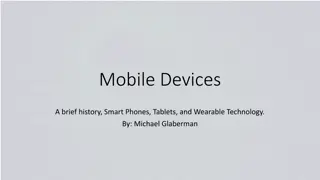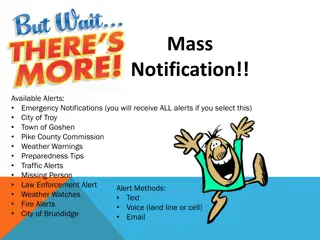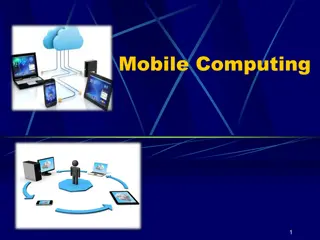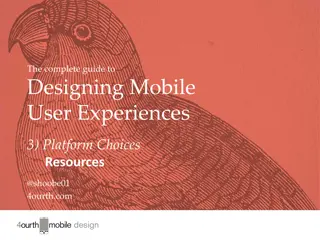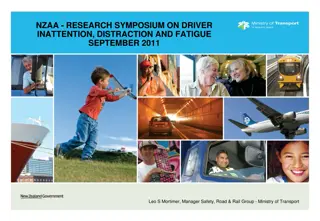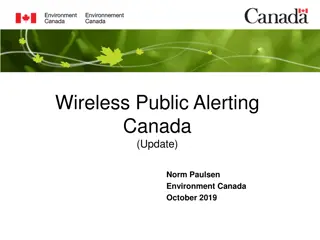Challenges of Sending Alerts to Mobile Phones During Emergencies
Sending alert messages to personal mobile phones during emergencies faces various challenges related to the complicated mobile network infrastructure, overload issues, and prioritization of messages. Disasters lead to significant spikes in network traffic, causing throttling and potential message blockages. The reliance on mobile networks for emergency communication highlights the need for robust solutions to ensure timely and effective alert delivery.
Download Presentation

Please find below an Image/Link to download the presentation.
The content on the website is provided AS IS for your information and personal use only. It may not be sold, licensed, or shared on other websites without obtaining consent from the author. Download presentation by click this link. If you encounter any issues during the download, it is possible that the publisher has removed the file from their server.
E N D
Presentation Transcript
Cell Broadcast Cell Broadcast The good news, the bad news and the promise going forward. Mark Wood Mark.wood@drcf.net OASIS CAP workshop, Amsterdam, 21 Sept 2022
What are we trying to do? We are trying to put an alert message on peoples personal mobile phones. About %60-%80 of the population carry a phone on their person at all times, at home, at work, on holiday. They pay for this device at their own expense They keep it charged up every night If it breaks they fix it immediately.
What is the problem? Normally, the only way to reach such devices is via their mobile network operator (MNO). The mobile network is a super complicated system with a lot more control signalling that a fixed network. ( the class for it takes 3 days!).
What is the problem? The control channels are designed and engineered to handle a normal business Friday afternoon. But they cant cope with very high levels of traffic far above and beyond their design.
What is the problem? Sadly, disasters always cause huge spikes of load on the system as everyone tries to contact their loved ones and get the family organised. Several official university Studies show that the offered traffic load spikes up to %400 in the first hour and %1000 by the end of the day. The load stays this high for several days.
What is the problem? So right when you need to use the mobile network, its already hugely overloaded. The network very often responds by placing itself in a very defensive mode, pacing itself, (Called Throttling) and flushing a lot of traffic.
What is the problem? To make matters worse, sometimes the network blocks all messages except those from priority override users such as police and other government officials. There is more of this as some countries have replaced their trunked radio systems with a mobile network solution. In London, during the recent bombings, all mobile networks were shut down for fear of remote control bombs being triggered by remote wireless activation.
You become the problem. Then at this moment, you decide to put 10 million SMS text messages into the system and expect them all to be delivered in a few seconds! Are you kidding me? If the network was not crashed before you pressed the button, it will a few seconds after you let your finger off the button.
You become the problem. No, you cant expand your way out of this problem by adding more capacity, because the constraint with mobile networks is the very small amount of spectrum that the network has been allocated by the government. There just is no more spectrum to add more capacity. So what we need is a solution that works when the network is in full congestion, with its servers crashed, and it is even pulling up the drawbridge to protect itself from serious harm. Frankly we need something that does work during a real disasters!
A solution is provided. The same members of the GSM committee (now called the 3GPP) who designed SMS, realised the limitations of it for such situations where a super large number of messages is needed all at once. SMS is a one to one system, with signalling needed for each device separately, which consumes a lot of signalling load and takes a long time. So in 1992, at the same time as providing SMS, they also included a complementary system for message delivery, called Cell Broadcast . Cell broadcast is not new, it has been resident in the system and the mobiles since the 90 s.
A Complementary method. The brilliant engineers at the GSM committee understood the new GSM system very well so they knew all the right answers. Cell Broadcast works exactly opposite to the way SMS works, which eliminates may of the problems that SMS has. But it also has its own problems that SMS does not have, and in many cases SMS is a perfectly good solution. To get the benefit of reliability during the acute phase of the disaster, emergency managers should know about its strengths and weaknesses, and make appropriate choices.
What the GSM engineers did.. The engineers decided to use Broadcast/Multicast technology for the complementary system, hence the name Cell Broadcast. A broadcast is like an FM radio station, the message is one way, no device is addressed by its number, and no device acknowledges receipt of the message. This means that there is no limit to the size of the population to be reached, whether 1 person or 10 Million people, it makes no difference to the network load. Thus CB will not crash your network.
What the GSM engineers did.. A cell is divided into; the Control Doman , parts of the spectrum reserved for machine to machine signalling to set up the calls. The traffic domain, where the customer traffic such as phone calls are made. The packet switched domain, where customer mobile data services are carried.
What the GSM engineers did.. The Control Domain has absolute priority in all cases for the cell, its capacity can never be used by customer traffic. One of its features is the Broadcast Control Channel, which is used to send technical information to the mobile phones. The mobile phones are always listening to the Broadcast Control Channel even when you are not using your device. The Broadcast Control Channel can not crash during spikes of overload. Nor can it overload as it is a broadcast channel, So that is where, in 1992, they put Cell Broadcast! (very cleaver).
The good, the bad and the ugly. This choice of using broadcast/multicast technology and also using the broadcast control channel did solve the problem, and CB is the most reliable method during the acute phase of the emergency. But is had other side effects, some of which are good, some of them are.. Well.. A problem. But don t worry all the problems can be solved.
The good guys.. A typical cell has a very small radius of about 1KM. Each cell has its own separate control channel. So we can send a different message to each cell if we want to, or more likely send one message to a group of cells, and another message to a different group of cells. Cell broadcast is natively and passively geo specific.
The good guys.. Every mobile device in the cell is listening to the broadcast control channel all the time, on a call or not. When the cell sends a cell broadcast text (or data) message, it sends it to all phones on that cell at the same moment. Within a few seconds all phones have the same message regardless of how many, even hundreds of millions. This makes CB fast.
The good guys.. The system does not need to know the phone number or IP address of the mobile device. Devices pick up the message passively, just like someone listening to an FM radio station. Therefore it does not need a data base of subscribers to perform look up, and send the messages one by one. End users don t need to subscribe to the service, or tell anyone its subjects of interest, you automatically get the right message just by being there.
The good guys.. In addition, since we contact the cell, which is fixed to a tower and is not moving, we don t need to know the location of the mobile device either. There is no location update signalling, nor data base of anyone's locations to worry about.
The good guys.. This removes a very large burden of reporting locations, maintaining a large data base, searching it for devices inside the area or polygon. This saves complexity and costs as well as saving time. Furthermore, privacy is guaranteed as there are no data privacy issues to worry about, and no service to subscribe to. The user can opt out any time by commanding the phone to disable certain types of message (except national messages which cant be disabled). There are no litigation problems for the network to worry about. Customers can relax because no matter how evil the network is, or how cunning their engineers, its impossible to reverse engineer anyone's identity or location with this technology. (but they can lawfully do this by other methods).
Problems with the solution. You don t need any kind of special permission from the mobile operator to send an SMS or to make phone call. But since CB operates via the control channel, no members of the public can access the control channel. It can only be accessed by the engineers of the mobile network. On the one hand this is good as its very hard to spoof a CB message as its very securely guarded, unlike SMS and social media. But this can only be done with the direct cooperation of the mobile network operators, their concerns over letting anyone in to their control system are obvious.
Problems with the solution. You can never send a CB message without the operators co operation and a lot of special integration engineering. This has costs to the network, without giving them a return on investment as since they don t know the identity of the receiving person, they cant bill him as is their usual business model. So they have to be incentivised, by compensation, quid pro quo or direct mandate to make them do it. How this negotiation is done depends of the government s relationship with the network, the networks attitude to the community and many other matters highly confidential to that relationship.
Problems with the solution. The broadcast control channel (BCC) is designed for very compact machine code messages, so it has a very narrow bandwidth and slow speeds. CB has been squeezed into a part of the system that is used to send the beacon signal , which is used by mobiles to measure the station signal to decide if it will move to another better cell. So the maximum size of a Cell Broadcast message is only 80 bytes per 1.8 seconds. You can send bigger messages by concatenating up to 15 messages into one, but this then takes a long time to send, and your in a hurry, right? So short text messages of 80 or 160 characters is best. But plans are in works to improve this a lot in 5G
Cell Broadcast Centre Once the regulatory framework negotiations have been done, or the network has decided that they have their own reasons to do CB, they need to do the following. Pay a licence fee to the vendor of the radio network equipment (Ericsson Huawi etc) to unlock the CB feature. Install an additional server called the Cell Broadcast Centre (CBC). These cost are a lot for a very small network to carry, so there are programmes for shared CBC services in works to make it affordable for them.
Cell Broadcast Centre The main job of the CBC is to decide which cells to address with which messages. The CBC takes the polygon in the CAP message, and reads the cell data base (created by the cell planning engineer), which give the locations and coverage of all cells in that network. The CBC then send the message to those cells which have coverage if the are mentioned in the polygon.
Cell Broadcast Centre The CBC sends the message to the cells in the polygon, but those cells are not designed to follow jurisdictional borders or features such as rivers, so there may be bleeding of the message out of the polygon, or sometimes no coverage in a part of the polygon. So the area where the message really appears can be a bit fuzzy round the edges. Therefore the message should always say in the text, which area is being referred to.
CMSP Gateway. CAP messages cannot be directly transmitted by CB, they are much too verbose for the very limited capacity of CB. So an additional server called the Commercial Mobile Service Provider CMSP gateway is needed. (sometimes it is built in to the CBC). It takes the CAP message, reads the area information or the polygon information and coverts it into the polygon that the CBC needs for Cell Selection. It needs to convert geocodes such as Kitsup County into a list of WGS84 co ordinates to create the polygon. CBCs don t know anything about place names or jurisdictions.
Device Based Geo Fencing (DBGF) The USA WEA system augments this by sending the polygon to the phone and letting the phone measure its own location and decide by itself if this message is relevant to the location or not. Note that it does not need to report its position to the network to do this. But there is a limit of 100 points to a polygon so that it does not take too long to send it over such a narrow band system. Not all phones have this new feature, so some will always be receiving the more coarse granularity of down to the cell they are in.
Bad guys Cell Broadcast does not know the either the location or the identity of any of the devices that it reaches. It does not know if it is working at all. So additional outer loop testing systems are needed to see how well it is working and get problems fixed quickly.
Bad guys Location Based SMS does keep a data base of the identity and location of all users in an area, so emergency managers can know how many people are in the area and roughly where they are. But Cell Broadcast knows nothing about the users so it cant give useful information like that.
The user equipment Ue The moble phone or tablet is called the User Equipment Ue. Cell broadcast is passive, just broadcasting the message to all phones. But the phone has to decide to receive the message, then know what to do with it. Also users can choose to opt out of particular types of message by using their menu system. No one knows if that was done, its done inside the phone. Ue behaviour varies from government to government, in particular the sound it makes varies. But as long as the national differences are not too great, and at least MI codes are common, it should work when you travel to another country.
Message Identifiers. Every cell broadcast message begins with a 16 bit code called the message identifier (MI), it says what sort of information this is. Currently the 3GPP standard lays out a few dozen of these, some of which are defined for public warning systems. Many countries follow the USA CMAS channel numbers, which are the same as the Korea Public Warning system and EU-ALERT, (but the Japanese MI codes are different as they came before the standard). But some countries use different codes, and this may prevent some users from getting messages. Its easy to solve these problems but it needs to be considered.
Further uses for CB However we can send a CB message using a different MI code, and this will not impact the alerting devices as they will ignore the message. This means we can use it for other purposes, commercial and civic. Teams are working on commercial uses for CB in order to incentivise networks to maintain the system. Other use cases may be for paging of off duty doctors and nurses, police officers and red cross volunteers. But that can only be done with the co operation of the mobile network provider, so some negotiation is needed.
Summary; Cell broadcast does solve the problem of working well during network overload events, but has narrow band capacity due to its fitting in to spare spectrum in the control channel. Its geo specificity is passive, selecting the cells rather than the mobile devices. This gives very low signalling loads but is a bit fuzzy around the edges. As its passive it gives no information as to how may people where in the area and where they are, unlike LB-SMS.
Summary Mobile phone behaviour depends on national requirements, which can differ. But as long as they have the same MI coding they should work when roaming. CAP cant be sent directly over CB, But CMSP gateways can convert the message and pass the text and polygon over to the CBC. In future, other uses for CB may be permitted by the operator. In 5G, the capacity of the CB channel will be improved and be less narrow band. Projects are soon to be launched to share CBC platforms so that smaller networks can afford to have CB.
Thank You, Any questions? mark.wood@drcf.net
